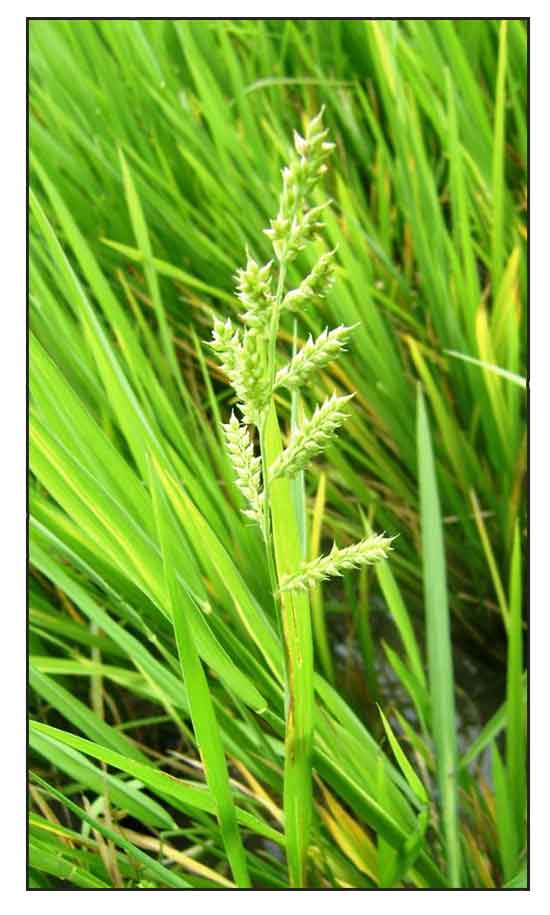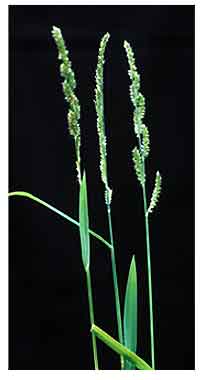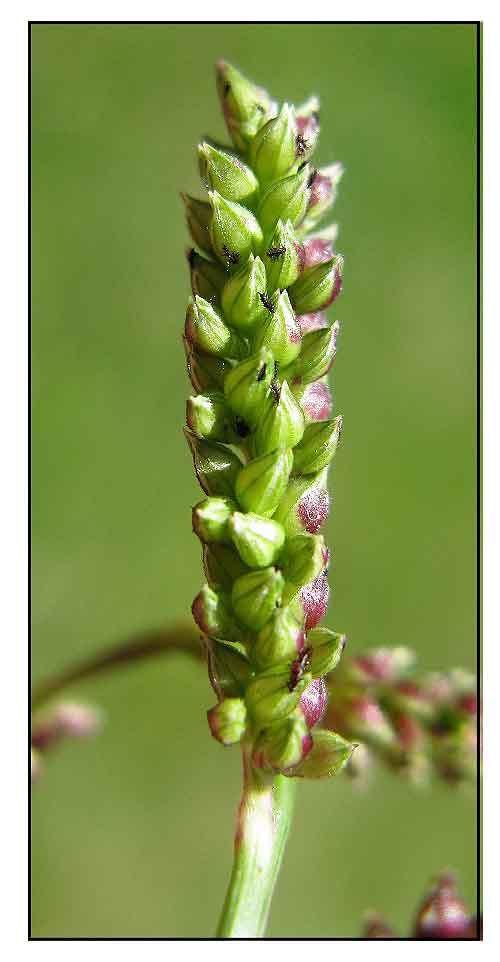 Gen info Gen info
- Echinochloa colona is a type of wild grass originating from tropical Asia. It was formerly classified as a species of Panicum. It is the wild ancestor of the cultivated cereal crop Echinochloa frumentacea, sawa millet. Some taxonomists consider the two taxa as one species. (4)
Botany
Echinochloa colona is a tufted annual grass with erect or ascending culms up to 1 m tall, often rooting at the lower nodes. Leaf-sheath 3-4 cm long, glabrous, often reddish; ligule absent; leaf-blade linear-acuminate, 5-30 cm × 2-8 mm, sometimes marked with purple bars. Inflorescence up to 15 cm long, composed of 3-10 short racemes up to 3 cm long; racemes neatly 4-rowed, simple, commonly half their length apart and appressed to the axis but sometimes subverticillate and spreading; spikelets numerous, ovate-elliptical to subglobose, 1.5-3 mm long, pubescent; lower floret male or barren, acute to cuspidate; upper lemma 2-3 mm long, sharply pointed. Caryopsis ellipsoid to subglobose. The absence of a ligule, the purplish-tinged leaves and the neatly 4-rowed racemes are characteristic of this species. Less constant are the awnless soft indumented spikelets - some forms tend to intergrade with E. crus-galli (L.) P. Beauv. which has awned spikelets. (3)
Distribution
- Native to the Philippines.
- Also native to Assam, Bangladesh, Borneo, Cambodia, China, Hainan, Himalaya, India, Jawa, Laos, Lesser Sunda Is., Malaya, Maluku, Myanmar, Nansei-shoto, Nepal, New Guinea, Pakistan, Sri Lanka, Sulawesi, Sumatera, Thailand, Tibet, Vietnam, etc. (1)
- The native range is Tropical and Subtropical Old World, in seasonally dry tropical biome. (1)
- In swampy places receiving 400 to 1200 mm rainfall per year, at altitudes from sea-level to 2000 m. (3)
 Constituents Constituents
- Phytoconstituent analysis yielded alkaloids, steroids, carbohydrates, glycosides, tannins, phenols, and flavonoids. Thin layer chromatography and MS isolated three compounds: ß-sitosterol, 2,3,4-trihydroxy-6-methyl benzoic acid, and ethyl 3,4,5-trihydroxy benzoate. Nutrient analysis yielded: protein 3-18% DM, high fiber content 25-45%, dry matter 26%, ash 14.5%, lignin 5.4%. Micronutrients include calcium 4.5 g/kg, phosphorus 2.2 g/kg, potassium 27.4 g/kg, sodium 2.2 g/kg, magnesium 2.8 g/kg, manganese 203 mg/kg, zinc 39 mg/kg, copper 8 mg/kg. (5)
Properties
- Jungle rice can present as a problem in rice fields as they closely resemble young rice plants.
- It is a fast-growing grass, germinating quickly with the onset of first rains, seeding abundantly, and can cover cultivated forages in the first few weeks. (3)
- Studies have suggested antioxidant, hepatoprotective, phytotoxic, herbicidal, antidiabetic, wound healing, antimicrobial properties.
Parts used
Tubers, seeds.
Uses
Edibility
- Seeds eaten by humans during famine times. Seeds are roasted and mixed with roasted seeds of wheat and bhang. (5)
- In India, seeds of the grass are used to prepare the festival fasting food dish "khichadi". In Rajasthan the seeds are boiled in water and used as a substitute for rice. seeds are also ground into flour, sometimes mixed with maize or blackgram, and made into bread or porridge. (5)
-
In Australia, panicles were used by aboriginals as food: seeds were pounded between stones, mixed with water, and made into bread. (4)
Folkloric
- In India, used in spleen and hemorrhage problems; also for nausea and constipation. Tuber considered anti-emetic and as sedative in dyspeptic disorders, especially in vomiting during pregnancy. (5)
- Caryopses (seeds) used for treatment of jaundice. (6)
Others
- Fodder: Used as forage; grazed by all kinds of stock. A palatable fodder for milking animals and water buffalo.
- Crafts: Stems used for weaving mats.
 Studies Studies
• Hepatoprotective / Antioxidant / Caryopses: Study evaluated the methanolic extract of caryopses (seeds) of E. colona for antioxidant and hepatoprotective activity in paracetamol and ethanol intoxicated rats and antihepatotoxic activity against D-galactosamine. The extract exhibited ferrous ion reducing power, DPPH, superoxide, nitric oxide and hydroxyl radical scavenging activities. Extract exhibited significant (p<0.001) hepatoprotective activity, which was attributed to flavonoids and phenolic compounds in the extract. (6)
• Phytotoxicity / Tricin / Bioherbicide for Weed Control: Study evaluated the phytotoxic potential of Echinochloa colona and its potential as a bioherbicide. A lettuce seed bioassay indicated that a dichloromethane (CH2Cl2) soluble fraction of MeOH extract has the most phytotoxic activity. The most phytotoxic compound of the fraction was identified as tricin, which was assessed on phytotoxicity on germination and seedling growth of ten weed species. Higher concentrations of the fraction (500,1000 mg L-1) and tricin (100, 200 µmol L-1) inhibited germination and seedling growth of most species. Results suggest potential for the fraction and tricin as bioherbicide for weed control in agriculture. (7)
• Antidiabetic: Study evaluated the antidiabetic activity of various fractions (chloroform, ethyl acetate, and ethanol) of ethanolic extract of E. colona using streptozotocin induced diabetic model in male Wistar rats. Results showed significant reduction in blood glucose level, total cholesterol and trigylceride levels. (8)
• Wound Healing: Study evaluated the wound healing activity of various fractions of ethanolic extract of E. colona using invivo guinea pig punch wound model and invitro wound assay an chick chorioallantoic membrane model. Among the fractions, the chloroform showed enhanced wound healing activity in guinea pigs and promoted wound contraction and angiogenesis in chick chorioallantoic membrane model. (9)
• Antimicrobial / Antioxidant: Study of methanolic and petroleum ether extracts of E. colona showed significant antimicrobial activity against Gram positive Staphylococcus aureus and Streptococcus pneumonia, Gram negative Escherichia coli and Pseudomonas aeruginosa, and fungal strains Aspergillus oryzae and A. niger. Most significant results were against S. aureus, with inhibition zones of 24 and 23 mm against S. aureus for methanolic and petroleum ether extracts, respectively. The methanolic extract showed significant antioxidant activity by ABTS, FRAP, metal chelating assay, total phenolic and flavonoid contents. The ME showed TPC and TFC of 734.25 and 7774.54 mg/ml. (10)
• Enhanced Phytoremediation with PSB / Pb-Contaminated Soil: Study evaluated the phytoremediating ability of E. colona for lead contaminated soil in combination with phosphate-solubilizing bacteria (PSB) as well as promoting growth of E. colona under Pb stress condition. Total 06 PSB (labeled from TB01 to TB06) were isolated. TB04 showed strongest phosphate-solubilizing activity. The TB04 strain was not affected by high Pb2+ concentration. TB04 strains was identified as Pseudomonas putida Trevisan. E. colona inoculated with TB04 strains significantly increased phytoremediation efficiency of Pb from Pb-contaminated soil and growth was enhanced. TB04 has potential as an inoculant in combination with Echinochloa colona for phytoremediation of metal-contaminated soil. (11)
Availability
Wild-crafted.
|

![]()





 Studies
Studies 